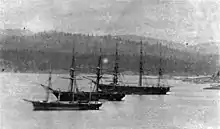HMS Malacca (1853)
HMS Malacca was a 17-gun sloop of the Royal Navy, launched in 1853.[2] She later served as the Tsukuba of the Imperial Japanese Navy.[1]
| History | |
|---|---|
| Name: | HMS Malacca |
| Ordered: | 9 November 1847 |
| Builder: | |
| Laid down: | 29 May 1849 |
| Launched: | 9 April 1853 |
| Completed: | 17 August 1854 |
| Commissioned: | 7 May 1853[1] |
| Decommissioned: | 1869[2] |
| Out of service: | Sold in June 1869 |
| Name: | Tsukuba[1] |
| Commissioned: | 1869[1] |
| Decommissioned: | 1906[1] |
| Reclassified: | Static training vessel c. 1900 |
| Fate: | Broken up in 1906 |
| General characteristics in British service | |
| Class and type: | |
| Displacement: | 1758 tons[2] |
| Tons burthen: | 1,034 28⁄94 bm |
| Length: | |
| Beam: | 34 ft 4 in (10.46 m) |
| Depth of hold: | 22 ft 8 in (6.91 m) |
| Installed power: | |
| Propulsion: |
|
| Speed: |
|
| Armament: |
|
| General characteristics in Japanese service | |
| Armament: |
|

Malacca was built to a design drawn up by the Surveyor’s Department and approved in 1848. She was ordered on 9 November 1847 from a Mr. Mould, at Moulmein, Burma and was laid down on 29 May 1849. She was launched on 9 April 1853, and completed by Mr. Ladd, the Government Inspector, the original builder, Mr. Mould, having failed in the meantime. She was sailed to Britain in May 1853, where she was given her engines and her fitting out was completed at Chatham Dockyard. She was undocked on 8 August 1854.
In January 1857, she rescued the survivors from the Royal Sicilian Navy ship Carlo III, which suffered a boiler explosion and sank in the Mediterranean Sea with the loss of more than half of her 100 crew.[3] After several years of service she was re-engined in 1862, and reclassified as a corvette at about this time. After serving for a further seven years, she was sold in June 1869 to E. Bates. Bates sold her later that year to the Imperial Japanese Navy, who took her into service as the Tsukuba. She served as a stationary training ship after about 1900, and was broken up in 1906.
Notes
- "Mid-Victorian RN vessel HMS Malacca". Retrieved 18 June 2012.
- "HMS Malacca". Retrieved 18 June 2012.
- "Naples". The Morning Chronicle (28099) (Second ed.). London. 14 January 1857.
References
- Jentschura, Hansgeorg; Jung, Dieter & Mickel, Peter (1977). Warships of the Imperial Japanese Navy, 1869–1945. Annapolis, Maryland: United States Naval Institute. ISBN 0-87021-893-X.
- Lacroix, Eric & Wells II, Linton (1997). Japanese Cruisers of the Pacific War. Annapolis, Maryland: Naval Institute Press. ISBN 0-87021-311-3.
- Lengerer, Hans (2020). "The Kanghwa Affair and Treaty: A Contribution to the Pre-History of the Chinese–Japanese War of 1894–1895". Warship International. International Naval Research Organization. LVII (2): 110–131. ISSN 0043-0374.
- Winfield, R.; Lyon, D. (2004). The Sail and Steam Navy List: All the Ships of the Royal Navy 1815–1889. London: Chatham Publishing. ISBN 978-1-86176-032-6.
